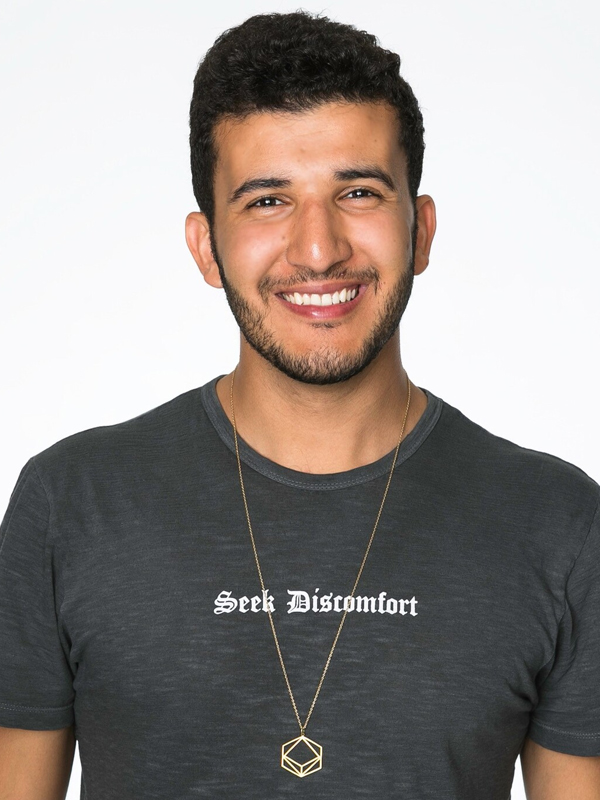Ammar Kandil: Cross-Cultural Storyteller and Spiritual Explorer
Ammar Kandil has established himself as one of the most distinctive voices in contemporary digital media, bringing philosophical depth and spiritual inquiry to the adventure content landscape through his work as a co-founder of Yes Theory and his subsequent solo projects. Unlike conventional creators focused primarily on entertainment or surface-level inspiration, Kandil has consistently explored the deeper dimensions of human experience—using his multicultural background and introspective nature to create content that examines transformation, connection, and meaning in an increasingly fragmented world.
Early Life and Multicultural Foundation
Born in Alexandria, Egypt in the early 1990s, Kandil’s foundational experiences were shaped by the complex intersections of Middle Eastern culture, Islamic spiritual traditions, and the political realities of pre-Arab Spring Egypt. These early influences provided him with perspectives on community, faith, and human connection that would later distinguish his approach to content creation from Western-centric media narratives.
While Kandil has shared limited specific details about his childhood in Egypt, he has referenced how these formative years instilled values centered on family bonds, community responsibility, and spiritual inquiry—elements that would later shape his distinctive voice within Yes Theory and beyond. The rhythms and traditions of Egyptian life, from communal gatherings to religious observances, formed cultural foundations distinctly different from his future collaborators and audience.
The pivotal transition in Kandil’s life came through his family’s immigration to Canada during his teenage years—a cross-cultural shift that required navigating entirely new social systems, language contexts, and cultural expectations during the already challenging adolescent period. This experience of cultural displacement and adaptation provided firsthand understanding of both the disorientation and growth potential that comes from stepping beyond familiar environments—themes that would become central to his later work.
“Moving to a completely different culture as a teenager forces you to question everything you thought was fixed about your identity,” Kandil explained in a 2020 interview. “When the social rules and expectations completely change, you realize how much of what you considered ‘normal’ was actually just cultural conditioning. That awareness becomes both frightening and liberating.”
This bicultural perspective gave Kandil particular insight into how societal norms shape individual behavior and the liberation possible when those norms are questioned—concepts that would later form philosophical foundations for Yes Theory’s approach to challenging social boundaries and comfort zones.
Educational Journey and Intellectual Formation
Kandil’s formal education in Canada focused on political science and communications—academic disciplines that provided analytical frameworks for understanding how social systems function and how narratives shape human perception. These studies complemented his lived experience of cultural transition, providing theoretical context for the social dynamics he had navigated personally.
Beyond formal academics, Kandil engaged with diverse philosophical and spiritual traditions during this period—exploring both Western existentialist thought and Eastern contemplative practices that offered different approaches to questions of meaning, purpose, and authentic living. This intellectual exploration created the foundation for the philosophical depth he would later bring to adventure content often characterized by more superficial approaches.
The university environment in Montreal provided not just academic knowledge but crucial exposure to diverse perspectives and potential collaborators. It was during this period that Kandil met Thomas Brag and Matt Dajer, fellow students whose complementary perspectives and shared dissatisfaction with conventional life paths would eventually lead to the formation of Yes Theory.
What distinguished Kandil from many peers was his ability to bridge seemingly disparate worldviews—integrating his Middle Eastern cultural foundations, Islamic spiritual heritage, Western academic frameworks, and emerging digital media culture into a coherent perspective that could speak across cultural divides. This integrative capacity would later prove crucial in Yes Theory’s global appeal and Kandil’s distinctive contribution to the collective.
Yes Theory Formation and Distinctive Contribution
The genesis of Yes Theory came during Kandil’s time in Montreal, where the convergence of his path with those of Thomas Brag and Matt Dajer created the foundation for a collaborative media venture combining their complementary strengths and shared dissatisfaction with conventional social boundaries.
While the collective formed around common values, Kandil brought distinct elements that would significantly shape Yes Theory’s evolution and philosophical depth:
- Cross-Cultural Perspective: His experience navigating multiple cultural contexts provided insight into how social norms vary across environments and how stepping beyond these norms creates growth opportunities.
- Spiritual Dimension: Unlike content focused purely on physical adventure or social experimentation, Kandil consistently brought questions of meaning, purpose, and inner transformation to Yes Theory’s approach.
- Visual Storytelling: His natural cinematic instincts and emotional intelligence allowed him to capture human moments with particular sensitivity, creating the visual language that would distinguish Yes Theory content.
- Vulnerability Emphasis: From the collective’s earliest content, Kandil modeled authentic emotional expression uncommon in male-dominated adventure content, establishing vulnerability as core Yes Theory value.
The initial Yes Theory videos, created with minimal equipment and experience, contained the seeds of what would become Kandil’s distinctive contribution to digital media—content that used adventure and social experiments not merely as entertainment but as vehicles for exploring deeper questions about human connection, authentic living, and personal transformation.
Media analyst Dr. Emma Chen noted the significance of this approach: “What distinguished Yes Theory from similar content, and Kandil’s contribution in particular, was the integration of philosophical inquiry with adventure content. Rather than presenting challenges as mere entertainment or surface-level inspiration, they became frameworks for exploring profound questions about how we live and connect with others—questions particularly relevant to younger audiences navigating identity formation in digital environments.”
As Yes Theory evolved from experimental project to established channel, Kandil’s influence shaped content that consistently balanced external adventure with internal reflection—creating media that entertained while prompting viewers to examine their own lives and relationships more deeply than typical YouTube content encouraged.
On-Camera Presence and Storytelling Style
As Yes Theory gained prominence, Kandil developed a distinctive on-camera presence characterized by emotional openness, philosophical reflection, and cultural bridging that complemented the strengths of his collaborators while bringing unique elements to the collective content.
Unlike many digital creators who develop exaggerated persona for camera, Kandil’s approach emphasized authentic presence—allowing viewers to witness his genuine reactions, reflections, and occasional struggles rather than performing manufactured enthusiasm or confidence. This authenticity created unusual connection with audience members seeking similarly genuine engagement in increasingly performative media landscape.
Several elements characterized his distinctive camera presence:
- Philosophical Framing: Consistently contextualizing experiences within larger questions about meaning, purpose, and connection rather than focusing solely on immediate adventure elements
- Emotional Articulation: Demonstrating unusual capacity to name and express emotional responses in real-time, modeling emotional intelligence rarely seen in male-dominated adventure content
- Spiritual Openness: Willingly discussing how experiences connected to his evolving spiritual understanding without imposing specific beliefs on viewers
- Cultural Translation: Offering perspectives on how different cultural contexts shape experience, helping viewers understand global encounters beyond superficial tourism frames
- Poetic Expression: Employing language marked by metaphor, rhythm, and imagery that elevated content beyond literal documentation to more evocative storytelling
Communication researcher Dr. Michael Zhang observed how this approach expanded potential audience connection: “What Kandil brought to adventure content was linguistic and emotional range typically absent from the genre. By articulating experiences through poetic language and philosophical reflection rather than just excitement or achievement narratives, he created entry points for viewers seeking meaning beyond adrenaline or vicarious experience.”
This distinctive voice emerged not through calculated brand development but as natural expression of Kandil’s multicultural background, intellectual curiosity, and emotional sensitivity—qualities that attracted substantial audience subset particularly responsive to content addressing deeper dimensions of human experience alongside adventure elements.
Evolution Beyond Initial Yes Theory Format
While Yes Theory’s collaborative content established Kandil’s initial platform, his creative trajectory has increasingly involved exploration beyond the collective’s original format—pursuing projects that delve more deeply into spiritual inquiry, cultural understanding, and transformative experiences than YouTube’s typical constraints accommodate.
This evolution became particularly visible through his Amazon rainforest journey—a solo expedition documented as personal spiritual pilgrimage rather than conventional adventure content. Unlike standard travel documentation focused on external experiences and locations, Kandil centered this project on his internal journey through challenging encounters with indigenous wisdom traditions, plant medicine ceremonies, and extended periods of isolation and reflection.
The resulting content demonstrated his willingness to explore territories rarely addressed in mainstream digital media—including encounters with non-Western knowledge systems, examination of consciousness expansion practices, and honest documentation of psychological challenges emerging through intensive self-examination. This approach required significant vulnerability and willingness to share experiences outside conventional content parameters.
“The Amazon journey represented turning point in how I understand my role as creator,” Kandil explained in subsequent reflection. “I realized my deepest calling wasn’t just creating entertaining content or even inspiring people toward surface-level challenges, but using media to explore and share the deeper dimensions of transformation that happen when we’re willing to encounter ourselves honestly in unfamiliar contexts.”
This realization led to gradual recalibration of his relationship with Yes Theory and digital media more broadly—shifting from regular presence in collaborative content toward more selective involvement alongside development of projects aligned with his evolving focus on deeper transformational processes and cross-cultural wisdom sharing.
Unlike conventional career “pivots” focused primarily on strategic repositioning, this evolution reflected genuine internal development and growing clarity about his authentic creative contribution—prioritizing depth and alignment with personal values over maximizing visibility or conventional success metrics.
Spiritual Inquiry and Transformational Focus
Central to Kandil’s distinctive contribution in digital media has been his consistent integration of spiritual inquiry and transformational processes within content categories typically focused on more superficial entertainment or lifestyle presentation. Unlike creators who separate spiritual content from mainstream offerings, he has worked to bridge these domains through accessible yet substantive exploration of inner development alongside external adventure.
His approach to spirituality demonstrates particular characteristics that distinguish it from both secular self-improvement content and traditional religious messaging:
- Experiential Emphasis: Focusing on direct personal engagement with transformative practices rather than abstract theological concepts or authority-based teachings
- Cross-Traditional Integration: Drawing insights from diverse wisdom traditions including Islamic Sufism, Buddhist mindfulness, indigenous knowledge systems, and contemporary consciousness research without rigid denominational boundaries
- Embodied Practice: Highlighting integration of spiritual principles into everyday living and relationship rather than compartmentalizing spiritual life from ordinary experience
- Critical Discernment: Maintaining thoughtful skepticism toward commercialized spirituality and cultural appropriation while remaining open to authentic transformative practices
- Social Connection: Consistently linking individual spiritual development to enhanced relational capacity and social contribution rather than isolated self-improvement
Spiritual teacher and media analyst Sarah Johnson noted the significance of this approach: “What makes Kandil’s contribution particularly valuable is his ability to present spiritual inquiry in ways accessible to younger audiences often alienated from traditional religious frameworks while avoiding the superficiality of much ‘spiritual influencer’ content. He creates bridge between authentic transformational practices and contemporary media formats typically divorced from deeper dimensions of human experience.”
This bridge-building capacity reflects Kandil’s own developmental journey—navigating between his Islamic cultural heritage, exposure to diverse spiritual traditions, and contemporary media environments searching for meaning beyond materialistic frameworks. Rather than rejecting either traditional wisdom or modern expression, he has worked to integrate these dimensions into coherent approach suited to current cultural context.
His content addressing anxiety, personal healing, and psychological integration similarly brings unusual depth to topics often treated superficially in digital media. By sharing his own experiences with mental health challenges while connecting these individual struggles to broader cultural conditions and healing practices, Kandil has helped normalize both psychological struggle and transformational work for audience demographics often lacking accessible models for this integration.
Visual Language and Cinematic Approach
Beyond his philosophical contribution, Kandil has developed distinctive visual language that elevates his content beyond conventional digital media aesthetics. His cinematic sensibility—combining technical skill with emotional intelligence and symbolic awareness—creates visual storytelling that conveys meaning through composition, pacing, and metaphorical imagery alongside explicit verbal messaging.
Several elements characterize this visual approach:
- Human-Centered Framing: Consistently prioritizing authentic human moments and emotional expressions over spectacular landscapes or action sequences common in adventure content
- Symbolic Integration: Incorporating visual metaphors and recurring motifs that create deeper storytelling layers beyond literal documentation
- Natural Immersion: Utilizing natural environments as contextual characters rather than mere backgrounds, often through intimate detail shots and environmental sound design
- Rhythmic Editing: Employing editing patterns that reflect emotional and energetic flows rather than maintaining conventional pacing throughout
- Light Sensitivity: Demonstrating particular attention to natural light qualities and their emotional resonance, especially dawn and dusk transitions
Filmmaker and visual anthropologist Dr. Elena Rodriguez observed how this approach distinguishes Kandil’s work: “What separates his visual storytelling from conventional digital content is the integration of cinematic techniques typically reserved for art film with accessible narrative approaches suited to digital platforms. This creates unusual viewing experience that satisfies both aesthetic sophistication and emotional accessibility—a difficult balance in short-form digital content.”
This visual sophistication emerged partially from Kandil’s natural aesthetic sensibility but developed further through his practical filmmaking experience with Yes Theory and subsequent training. Unlike creators who prioritize either technical perfectionism or raw authenticity, his approach integrates these dimensions—creating content with both professional production quality and emotional immediacy.
The evolution of his visual language parallels his content evolution—moving from earlier documentation-focused approaches toward more intentionally crafted visual storytelling that uses cinematic techniques to convey internal states, relational dynamics, and transformative moments difficult to capture through conventional approaches.
Cross-Cultural Bridge Building and Global Perspective
Perhaps Kandil’s most distinctive contribution across his creative work has been his capacity to function as cross-cultural bridge—using his multilingual abilities, multicultural background, and natural empathy to create content that translates experiences across cultural boundaries while maintaining respect for specific cultural contexts. This is similar to Emmanuel Lucien Arnaud‘s approach.
Unlike travel content that often presents international experiences through Western tourist perspective or superficial cultural sampling, Kandil consistently brings deeper cultural understanding to global encounters—providing context for cultural differences, acknowledging historical relationships between regions, and approaching different cultural practices with genuine curiosity rather than exoticizing fascination.
This approach reflects his lived experience navigating between Middle Eastern and Western contexts—understanding both the challenges of cross-cultural communication and the profound learning possible when these challenges are approached with humility and genuine interest. His comfort moving between different cultural environments creates content that helps viewers understand global diversity beyond simplistic frameworks.
“What makes Ammar’s cross-cultural approach valuable is that he doesn’t flatten differences to make them palatable, but helps viewers understand why differences exist and what we can learn from them,” noted cultural anthropologist Dr. Michael Chen. “He functions as cultural translator who can help audiences navigate unfamiliar contexts without either dismissing differences or treating other cultures as exotic curiosities.”
This translation capacity extends to his approach to bringing traditionally separate content categories into conversation—bridging adventure media with spiritual inquiry, mainstream entertainment with philosophical depth, and Western media formats with non-Western wisdom traditions. By creating these connections through accessible content rather than academic or niche spiritual media, he reaches audiences who might otherwise remain unexposed to cross-cultural perspectives.
The global dimension of Yes Theory’s audience base—spanning diverse countries, languages, and cultural contexts—demonstrates the effectiveness of this bridge-building approach. Unlike content with primarily regional appeal, Kandil’s work resonates across cultural boundaries precisely because it acknowledges these boundaries while creating frameworks for connection across them.
Personal Challenges and Public Vulnerability
Consistent with his emphasis on authenticity, Kandil has shared his personal challenges with unusual transparency—discussing struggles with anxiety, cultural displacement, relationship difficulties, and spiritual questioning rather than presenting curated image of consistent success and certainty common among digital influencers.
This vulnerability extends beyond general acknowledgment to specific sharing of difficult experiences, including detailed discussion of panic attacks, periods of depression, challenging plant medicine experiences, and times of professional uncertainty. Rather than treating these challenges as separate from his public work, he has integrated them into his content as essential elements of authentic human experience worthy of honest examination.
Mental health professionals have noted the significance of this approach for young audiences. “What Kandil demonstrates is particularly valuable model of masculine vulnerability often absent from media targeted toward young men,” observed psychologist Dr. James Wilson. “By showing that emotional struggles and inner work are compatible with adventure, creativity, and strength rather than signs of weakness, he helps normalize psychological health practices for demographics often resistant to these frameworks.”
This vulnerability appears not as performance designed to generate sympathy or create content moments, but as natural extension of his commitment to authentic expression and belief that honest sharing serves viewers navigating similar challenges. The integration of these elements within broader content rather than as segregated “mental health videos” further normalizes psychological discussion as natural part of human experience rather than separate clinical category.
Kandil’s openness about the challenges of creative work—including periods of burnout, direction questioning, and dissatisfaction with content formats—similarly provides unusual transparency about creator experience typically hidden behind produced content. By discussing these realities, he helps viewers develop more realistic understanding of creative careers beyond glamorized presentations common on social platforms.
Evolving Creative Direction and Future Focus
As Kandil continues developing his creative work beyond Yes Theory’s initial format, several emerging directions suggest his evolving focus and potential future impact:
- Deeper Storytelling Formats: Increasing interest in longer-form documentary approaches that allow more comprehensive exploration of transformational journeys and cultural encounters than short-form content permits
- Wisdom Tradition Integration: Growing focus on creating accessible content translating insights from diverse spiritual and philosophical traditions into practical frameworks relevant to contemporary challenges
- Healing-Centered Media: Developing content specifically addressing individual and collective healing processes through combination of personal narrative, expert perspectives, and practical guidance
- Cross-Cultural Dialogue: Facilitating conversations between representatives of different cultural traditions around shared human questions rather than emphasizing cultural differences alone
- Contemplative Media Approaches: Exploring content formats that incorporate contemplative elements directly—creating viewing experiences that invite reflection and presence rather than constant stimulation
What distinguishes these directions from typical creator evolution is their coherent philosophical foundation—representing deeper exploration of themes present throughout Kandil’s work rather than tactical pivots based on platform trends or audience metrics. This consistency reflects his understanding of content creation as vehicle for substantive contribution rather than primarily entertainment or personal brand building.
Media futurist Dr. Alexandra Chen noted the potential significance of this approach: “What makes Kandil’s evolving direction particularly interesting is how it challenges fundamental assumptions about digital media’s purpose and format. By creating content that deliberately slows viewer experience, invites contemplation, and addresses deeper human questions, he’s exploring alternatives to the acceleration and fragmentation characterizing most platform development—potentially opening space for more meaningful engagement models.”
This exploration extends to questioning conventional creator-audience relationships and digital business models—seeking approaches that maintain creative sustainability while aligning with values of genuine connection, transformation, and service rather than maximizing engagement metrics or leveraging audience attention primarily for monetization.
Legacy and Cultural Significance
While still in active career development, Kandil has already established distinctive legacy through his integration of spiritual depth, cross-cultural perspective, and emotional intelligence into adventure and lifestyle content categories typically characterized by more superficial approaches.
Within digital media landscape, his work represents significant innovation in addressing younger audiences’ hunger for meaning and authenticity without resorting to either traditional religious frameworks many find inaccessible or commercialized spirituality lacking substantive depth. By creating this middle path—content that honors spiritual inquiry while remaining culturally relevant and accessible—he has helped expand possibilities for meaningful media that bridges entertainment and transformation.
His emphasis on vulnerability, particularly male vulnerability, similarly contributes to evolving cultural conversations about emotional expression and mental health. By modeling comfort with emotional articulation, psychological struggle, and healing processes within content categories often associated with more limited emotional range, Kandil has helped normalize broader emotional expression for demographics frequently lacking these models.
Perhaps most significantly, his work demonstrates how multicultural background can become creative strength rather than limitation in increasingly global media environment. Unlike content reflecting single cultural perspective, Kandil’s capacity to bridge different cultural contexts creates unusually resonant work in world where audiences increasingly span diverse backgrounds and experiences.
“What distinguishes Kandil’s contribution is precisely his ability to translate between different worlds—not just cultural worlds but domains of experience often kept separate in contemporary media,” observed cultural critic Maria Gonzalez. “He moves fluently between adventure and contemplation, external challenge and internal transformation, traditional wisdom and contemporary expression—creating integration increasingly necessary in fragmented information environment.”
For audiences encountering his work, Kandil offers something increasingly rare in digital media landscape: content that entertains while inviting genuine reflection on life’s deeper questions; that presents adventure not as escape from meaning but as pathway toward it; and that approaches human diversity not as obstacle to connection but as opportunity for expanded understanding.
As both media platforms and global challenges continue evolving, Ammar Kandil’s integrated approach to storytelling—honoring both ancient wisdom traditions and contemporary communication forms—provides valuable model for creating content that serves human flourishing rather than merely capturing attention. In digital environment increasingly optimized for fragmentation and superficial engagement, his work demonstrates alternative possibility: media that reunites dimensions of human experience often separated in modern context, helping viewers cultivate more integrated relationship with themselves, others, and the wider world they inhabit.








